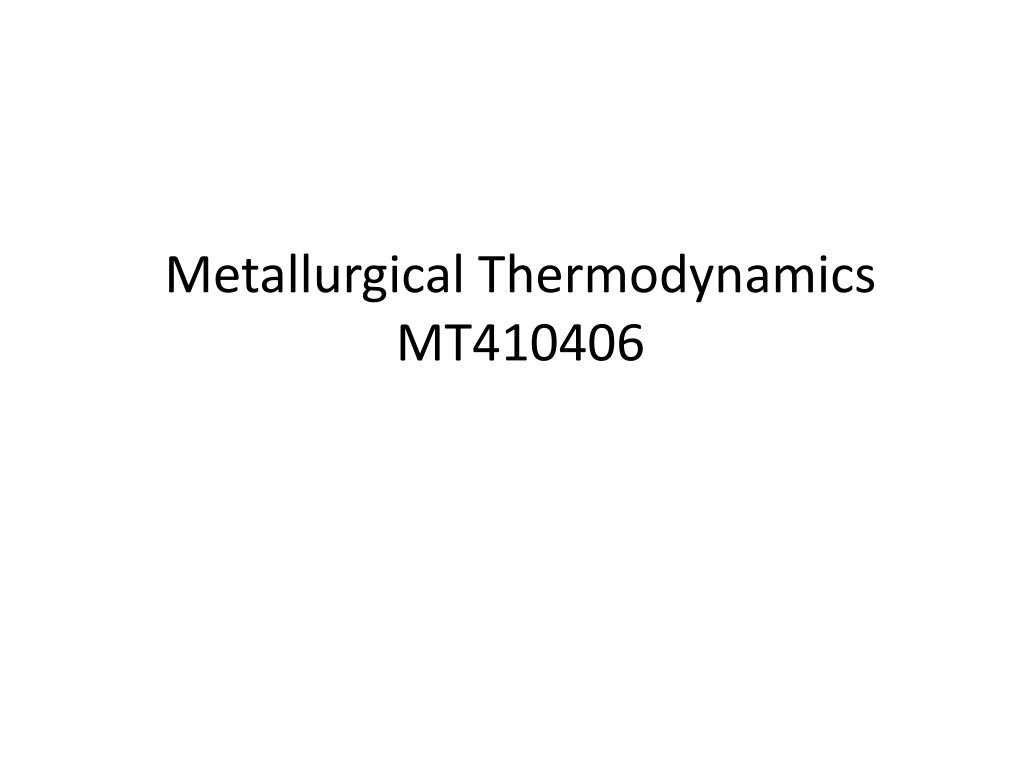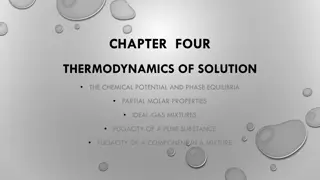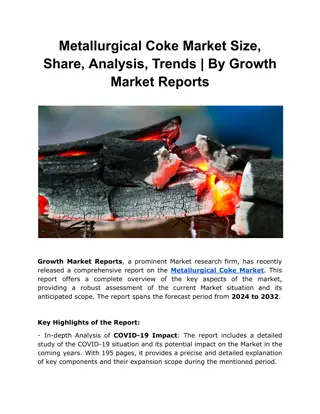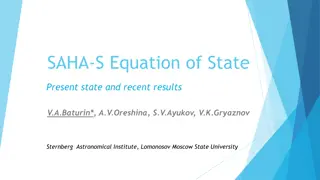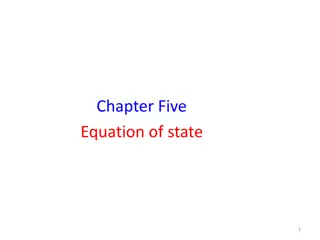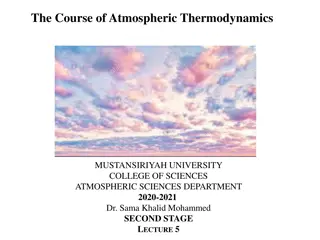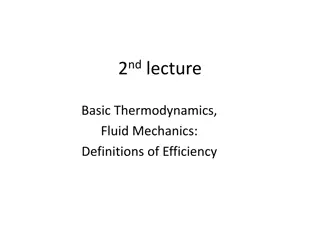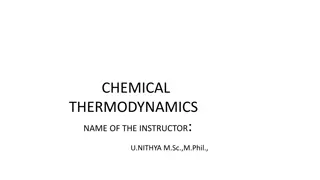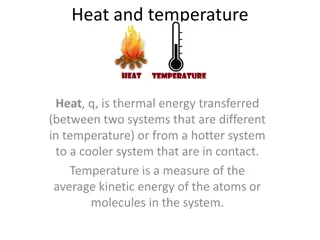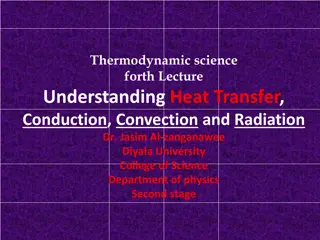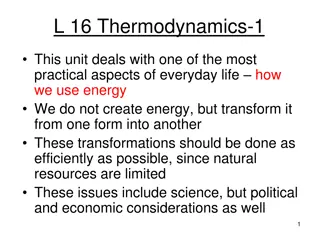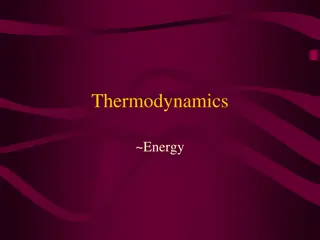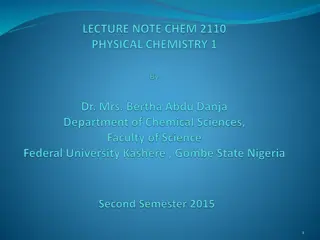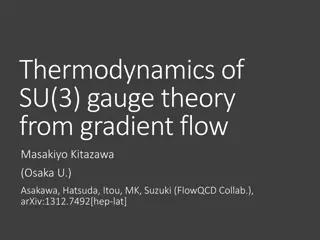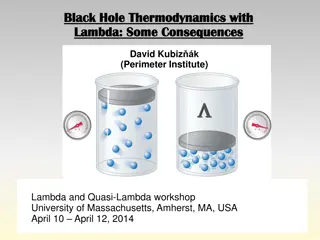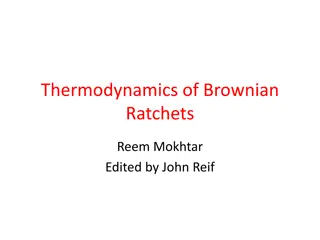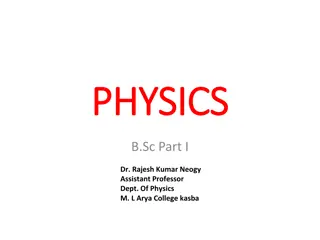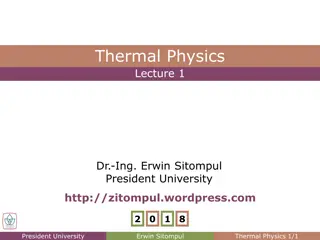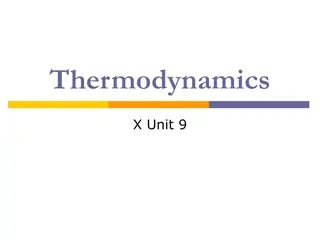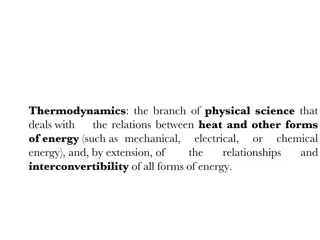Metallurgical Thermodynamics MT410406
This syllabus covers the basics of metallurgical thermodynamics including concepts like thermodynamic terms, system equilibrium, laws of thermodynamics, heat capacities, entropy, Gibbs-Helmholtz relations, Ellingham diagram, phase relations, and more. It also includes a grading structure for internal evaluation and exams.
Download Presentation

Please find below an Image/Link to download the presentation.
The content on the website is provided AS IS for your information and personal use only. It may not be sold, licensed, or shared on other websites without obtaining consent from the author.If you encounter any issues during the download, it is possible that the publisher has removed the file from their server.
You are allowed to download the files provided on this website for personal or commercial use, subject to the condition that they are used lawfully. All files are the property of their respective owners.
The content on the website is provided AS IS for your information and personal use only. It may not be sold, licensed, or shared on other websites without obtaining consent from the author.
E N D
Presentation Transcript
Metallurgical Thermodynamics MT410406
Time Table Time 09:00 TO 09:55 09:55 TO 10:50 11:00 TO 11:55 11:55 TO 12:50 12:50 TO 13:30 13:30 TO 14:40 14:20 TO 15:10 MON TUES WED THURS FRI MT(SC) LH-3 MT(SC) LH-3 MT(SC) LH-3 BREAK TUT MT C1 (SC) LH-3/ TUT TUT MT C2 (SC) Lab 1/ MT C3 (SC) 15:10 TO 16:00
Syllabus Outline Unit 1 Importance of thermodynamics, Definition of thermodynamic terms, Concept of system, states and equilibrium, Types of system, Extensive and intensive properties, Homogeneous and heterogeneous systems, Quasistatic process, Zeroth law of thermodynamics. Unit 2 First law of thermodynamics, Internal energy, Heat capacity, Specific heat and latent heat, Enthalpy, Isothermal and adiabatic processes, State properties, Heat of reaction, Heat of formation, Standard heats, Heat of transition, Hess s law, Kirchhoff s law equation. Second law of thermodynamics, Entropy of irreversible processes, Auxiliary functions, combined statements of 1stand 2ndlaws, Maxwell s relations, Gibb s-Helmholtz relations. Third law of thermodynamics, Clausius Clapeyron equation, Temperature dependence of entropy, Statistical interpretation of entropy, Consequences of third law, Nernst heat theorem, Equilibrium constant, Van-Hoff equation, Concept of fugacity, activity and mole fraction
Syllabus Contd. Unit III Ellingham diagram in detail for metal oxides, Activity, Gas phase Reactions (H2O- H2 and CO2 CO mixtures), Reactions involving solid and gases, Activities in concentrated solution, Activity in industrial liquid metallic solution, Thermodynamics of solutions, Gibb s-Duhem equation, Partial molar properties of mixing, Ideal solution, Raoult s law, Henry s law, Nonideal solution Unit IV Excess functions, Concept of 1 wt% standard state and Interaction coefficient, Regular solutions, Sievert s law-residual gases in steel Phase relations and phase rule-its applications, Free energy-composition and temperature-composition diagrams for binary alloy systems and their correlation, determination of liquidus, solidus and solvus lines, Effect of pressure on phase transformation and phase equilibrium Books: 1. Introduction to Metallurgical Thermodynamics, R. H. Tupkary, T. U. Publishers, (1995). 2. Introduction to Materials and Metallurgical Thermodynamics, A. Ghosh, PHI, (2009). 3. Metallurgical Thermodynamics and Kinetics and Numericals by S.K. Dutta and A.B. Lele, S. Chand (Available in Dept. library)
Grading Internal Evaluation = 40 Marks (Minimum Passing Marks = 16) Mid-semester exam = 30 Marks CIE = 10 Marks (Tutorial submission) End semester exam = 60 Marks Minimum Passing Marks - 24
Unit I Importance of thermodynamics, Definition of thermodynamic terms, Concept of system, states and equilibrium, Types of system, Extensive and intensive properties, Homogeneous and heterogeneous systems, Quasistatic process, Zeroth law of thermodynamics.
Thermodynamics - Basics Thermodynamics: It relates heat energy to other forms of energy and work. It is the study of changes in energy accompanying chemical and physical transformation It is the study of energies involved in a reaction and thereby, provides information on driving force behind the reaction Applications: Prediction of process feasibility Calculation of equilibrium composition of coexisting phases Properties of metallurgical solutions Phase equilibria, phase diagrams Electrometallurgy Interfacial phenomena Calculation of heat requirements of processes Usefulness Non-atomic approach Concerned with initial and final macroscopic states Simple and powerful tool for quantitative calculations and feasibility of reaction
Thermodynamics Basics (Contd.) Limitations: It can t predict structures of materials It can t predict rate of transformation/reaction It can t predict mechanism of the reaction Thermodynamics Chemical Thermodynamics: Applied to chemical reactions Metallurgical Thermodynamics: Application of chemical thermodynamics to metallurgical processes in extractive metallurgy, phase equilibria, phase transformation etc.
Basic Terms Used in Thermodynamics Reactor Apparatus in which chemical reaction takes place Reaction mixture: Entire material within the reactor System and Surrounding: Any portion of the universe under consideration that is closed by boundary is called system. Rest of the universe is surrounding Isolated system: Enclosed by impermeable walls to prevent exchange of matter or energy with the surrounding (Example: Coffee in a well insulated bottle) Closed system: Enclosed by impermeable walls to prevent exchange of matter with the surrounding (Example: A tightly capped coffee bottle) Open system: Enclosed by permeable walls that allow exchange of energy and matter with the surrounding. (Example: An open cup of coffee) Boundary wall: Adiabatic Non-adiabatic
Basic Terms (Contd.) Homogeneous system: Chemically uniform (made of single phase e.g. liquid metal, slag) Heterogeneous system: Chemically not uniform (made of two or more phases e.g. mixture of liquid metal and slag) Process: When two or more than 2 parameters changed, system gets changed and process occurs. Cyclic process: Sequences of prcessess which returns back to its initial point. Isobaric process: Net pressure change = 0 Isochoric process: Net volume change = 0 Isothermal process: Net temperature change = 0 Adiabatic process: Net heat exchange = 0 Quasi-static process: A quasi-static process is one that occurs slowly enough that a uniform temperature and pressure exist throughout all regions of the system at all times.
Isobaric Process An isobaric process is one that occurs at constant pressure. ( ) = = P = P As V W Fs W = work done on the system ( ) = = W P V P V V Isobaric process: f i
Isobaric Process ( ) = = W P V P V V f i Work by the system is the area under a PV graph. Work is path dependent
Example: Isobaric Expansion of Water One gram of water is placed in the cylinder and the pressure is maintained at 2.0x105Pa. The temperature of the water is raised by 31oC. The water is in the liquid phase and expands by the small amount of 1.0x10-8m3. Find the work done and the change in internal energy. = W P ( 0 . 2 V )( 0 . 1 ) = . 0 = 0020 ) C J 5 8 3 10 Pa 10 4186 m W ( ( ) ( . 0 ) = = = 130 J 0010 kg J kg 31 C Q mc T = + = 130 = J . 0 0020 J 130 J U Q W
Isochoric Process isochoric: constant volume = Q = + U Q W = = 0 W P V
Example: Work and the Area Under a Pressure-Volume Graph Determine the work for the process in which the pressure, volume, and temperature of a gas are changed along the straight line in the figure. Since the volume increases, the work is positive. Estimate that there are 8.9 colored squares in the drawing. ( 0 . 2 J )( 0 . 1 ) = 9 . 8 180 = 5 4 3 10 Pa 10 m W W
Consider the pressure-versus-volume plot shown. There are eight points labeled and the choices below indicate possible multi-step processes. In which one of the processes does the work done have the largest value? a) G H B D b) G F B D c) H A B D d) E D F H e) C B F G
Consider the pressure-versus-volume plot shown. There are eight points labeled and the choices below indicate possible multi-step processes. If the initial state of the system is at A and the final state is at E, which of the following paths between these two states results in the largest increase in internal energy of the system? a) A H D E b) A B F E c) A G E d) A C E e) All paths between A and E are equivalent for internal energy.
An isobaric process is represented by which one of the following graphs? a) A b) B c) C d) D e) E
An insulated container with rigid walls has two compartments within. One compartment contains n moles of an ideal gas and the other compartment has been evacuated. A valve connecting the two chambers is opened at time t = 0 s. Which one of the following statements concerning this situation is true? a) There is no change in the internal energy of the gas. b) There is no change in the pressure of the gas. c) The temperature of the gas decreases with time. d) Work is done by the gas as it fills the previously evacuated compartment. e) The gas will remain in the first compartment unless heat is added to the system.
In which of the following cases is a system undergoing an isobaric process? a) The system is placed within a thermal bath held at constant temperature. b) The system is an ideal gas enclosed in a container with a piston that may move up or down. A heavy object is placed on top of the piston. c) The system is an ideal gas enclosed in a container that is in contact with an object that is continually kept warmer or cooler than the gas within the system. d) The system is an ideal gas enclosed in a container has a constant volume. e) The system is an ideal gas enclosed in a container that is connected to a source of the gas from which gas may be added or removed to maintain a constant pressure.
In which of the following cases is a system undergoing an adiabatic process? a) The system is placed within a thermal bath held at constant temperature. b) The system is an ideal gas enclosed in a container with a piston that may move up or down. A heavy object is placed on top of the piston. c) The system is an ideal gas enclosed in a container that is in contact with an object that is continually kept warmer or cooler than the gas within the system. d) The system is an ideal gas enclosed in a container has a constant volume. e) The system volume is changed rapidly.
Isothermal Expansion or Compression of an Ideal Gas Work is the area under a PV graph integral V VPdV = f W Calculus Alert! i nRT V = f Isothermal expansion or compression of an ideal gas W dV V V i dV V = f W nRT V V i dx V x = f ln ln f x x = ln f i x V x i i V = ln i W nRT V f
Example: Isothermal Expansion of an Ideal Gas Two moles of the monatomic gas argon expand isothermally at 298K from and initial volume of 0.025m3 to a final volume of 0.050m3. Assuming that argon is an ideal gas, find (a) the work done by the gas, (b) the change in internal energy of the gas, and (c) the heat supplied to the gas. V (a) 31 = ln i W nRT V ) ( f 3 0 . 0 25 m ( 0 . 2 ( ) )( ) = 3400 = J mol . 8 J mol K 298 K ln W 3 . 0 050 m = Q= = = W 0 U nRT + = nRT 3 3 (b) f i 2 Q 2 U W 3400 (c) J
Adiabatic Expansion/Compression of a Monatomic Ideal Gas Adiabatic: no heat transfer = + U Q W 3 = U nR T 2 ( ) =2 W nR T T 3 f i i o = P V P V i o
A cylinder with a moveable piston contains an ideal gas. The gas is subsequently compressed adiabatically. Which of the following choices correctly identifies the signs of (1) the heat exchanged with the environment, (2) the work done, and (3) the change in the internal energy? a) (1) is zero, (2) is negative, and (3) is negative b) (1) is negative, (2) is positive, and (3) is negative c) (1) is zero, (2) is negative, and (3) is positive d) (1) is zero, (2) is positive, and (3) is positive e) (1) is positive, (2) is negative, and (3) is zero
Two moles of an ideal gas have an initial Kelvin temperature T0 and absolute pressure P0. The gas undergoes a reversible isothermal compression from an initial volume V0 to a final volume 0.5 V0. How much heat is exchanged with the environment, specifying whether it is absorbed or released? a) Heat is released to the environment and its value is Q = 0.5P0V0. b) Heat is absorbed from the environment; and its value is Q = 0.5P0V0. c) No heat is exchanged with the environment. d) Heat is released to the environment; and its value is Q = P0V0ln 2. e) Heat is absorbed from the environment; and its value is Q = P0V0ln 2.
Consider the pressure-volume graph shown for an ideal gas that may be taken along one of two paths from state A to state B. Path 1 is directly from A to B via a constant volume path. Path 2 follows the path A C B. How does the amount of work done along each path compare? a) W1 = W2; and the value is not equal to zero b) W1 = W2 = 0 c) W1 > W2 d) W1 < W2 e) It is not possible to compare the work done along each path without knowing the values of the temperature, pressure, and volume for each state.
Consider the following pressure-volume graphs. Which of these graphs represents the behavior of a gas undergoing free expansion? a) A b) B c) C d) D e) None of the graphs represent a gas undergoing free expansion.
A gas is enclosed in a cylinder by a piston. The volume of the gas is then reduced to one half its original value by applying a force to the piston. Which one of the following statements concerning the internal energy of the gas is true? a) The internal energy of the gas will decrease. b) The internal energy of the gas will increase. c) The internal energy of the gas will neither increase nor decrease. d) The internal energy of the gas will equal the work done in moving the piston. e) The internal energy of the gas may increase, decrease, or remain the same depending on the amount of heat that is gained or lost by the gas.
Basic Terms (Contd.) Isothermal Adiabatic q 0 (Heat is exchanged between system and surrounding; T is constant q = 0 (Heat is not exchanged between system and surrounding; T varies Since q = 0; As per 1st law of thermodynamics, dE = - w E is a state variable, (i.e. definite quantity, independent of path followed) Since T is constant, internal energy change ( ) = 0. As per 1st law of Thermodynamics, q = dE + w or q = w Both q and w are not state variables (i.e. depends on path followed) Ideal gas equation: PV = constant Ideal gas equation: PV = constant; = Cp/Cv Isothermal P Adiabatic V
Basic Terms (Contd.) Property: It is a measurable characteristic of a system that is in equilibrium. State: A set of properties that describes the conditions of a system. Eg. Mass (m), Temperature (T), volume (V) State of a system is defined by its variables or properties State variables: P, T, V, Viscosity, Surface tension (does not include atomic properties or atomic arrangement), Equation of state (which depends on state variable such as P, V, T, n (e.g. PV = nRT) State properties Extensive properties: Varies with its size or mass (e.g. M, V, E, H, S, G); Properties are additive: V = V1+V2+V3 Intensive properties: Independent of its size or mass (e.g. T, P, density, viscosity, refractive index, molar energy); Properties are not additives: T T1+T2+T3
Basic Terms (Contd.) Reversible and Irreversible Changes If the force in the system and external force opposing the change differ by an infinitesimal amount, the process is reversible. It goes through number of stages. It is slow, impractical, and has maximum efficiency Equilibrium non-equilibrium equilibrium Irreversible process involves spontaneous movement of system from non-equilibrium state to equilibrium state Non-equilibrium > equilibrium
Basic Terms (Contd.) Equilibrium: No changes occur in its thermodynamic state without the intervention of an external agency. e.g.: Chemical equilibrium Rate of forward reaction = rate of backward reaction Types of Equilibrium Mechanical Equilibrium (Pressure within a system is same at all points) Thermal Equilibrium (Temperature within a system is same at all points). Chemical equilibrium (Chemical potential of all components are same within a system) Thermodynamic equilibrium: mechanical equilibrium + thermal equilibrium + chemical equilibrium
Basic Terms (Contd.) Equilibrium properties with time. (1) Stable equilibrium (2) Meta-stable equilibrium A system shows no further tendency to change its
Basic Terms (Contd.) Simple Equilibrium W At Equilibrium: Case 1: Pressure exerted by gas on piston = pressure exerted by piston on gas (i.e. P is constant) T1 T2 V1 V2 Gas Case 2: Temperature of the gas = Temperature of the surrounding (i.e. T is constant) P1 P2 V1 V2
Basic Terms (Contd.) Forms of Energy Kinetic Energy Potential Energy Dynamic energy (Kinetic + Potential) Mechanical Energy = Work done = Force x distance Heat energy Electrical energy Chemical energy Surface energy Nuclear energy Geothermal energy Wind energy Tidal energy Solar energy
Basic Terms (Contd.) Internal Energy: Inbuilt energy responsible for the existence of the matter (E). Cyclic Process A Internal Energy = Kinetic Energy + Potential Energy + Energy of atoms/molecules + energy of interaction amongst atoms/molecules 1 P 2 Total change in internal energy for a cyclic process (A1B B2A) = 0 B EA1B + B1A = EA1B + EB2A = 0 T For cyclic process: Change in Internal Energy = Change in heat energy (q) Work Done (W) EA1B + EB2A = 0 = q W For cyclic process: q = W Energy Entering Energy Leaving = Change of Energy stored in the system
Characteristics of Internal Energy Depends on P,T, V, n It is a state property (i.e. depends on the initial and final state independent of path by which the system moved) Internal Energy is the sum of energy associated with translation motion, vibration motion and electronic configuration For cyclic process Change in internal energy = 0 Internal energy is a perfect differential; i.e. Ei = f(Pi,Vi,Ti) E E At constant temperature = + = V ( , ) dE dV dP f P T V P P V E E At constant pressure = + = V ( , ) dE dV dT f T P V T T V E E At constant volume = + = ( , ) dE dP dT f P T V P T T P
Zeroth Law of Thermodynamics The forgotten Law of Science Two systems are said to be in thermal equilibrium if there is no heat flow between them when they are brought into contact. Temperature is the indicator of thermal equilibrium in the sense that there is no net flow of heat between two systems in thermal contact that have the same temperature. If body A and B are each in thermal equilibrium with a third body C, they are also in thermal equilibrium with each other. TA = TC and TB = TC => TA = TB The aim of classical thermodynamics is to establish the relationships which exist between equilibrium state of a given system and the influences which are brought to bear on the system.
Quiz Which one of the following situations is described by the zeroth law of thermodynamics? a) An air conditioner transfers heat from the inside of a house to the outside of the house. A monatomic gas is held within a container that has a moveable piston. The gas absorbs heat from the surroundings and expands at constant pressure and temperature. A container with adiabatic walls holds boiling water. A thermometer is calibrated by inserting it into the boiling water and allowing it to reach thermal equilibrium with the water. A pot contains oil at 175 C. When frozen sliced potatoes are dropped into the oil, heat is transferred from the oil to the potatoes. A physicist removes energy from a system in her laboratory until it reaches a temperature of 3 10 10 K, a temperature very close to (but still greater than) absolute zero. b) b) d) e)
